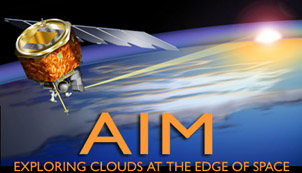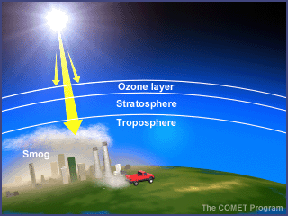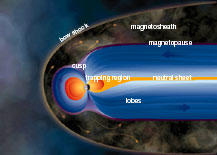Click on image for full size
Courtesy of NASA (Hampton University)
Space Missions to study Earth's Atmosphere & Climate
Television weather forecasts in the space age routinely feature satellite views of cloud cover. Cameras and other instruments on spacecraft provide many types of valuable data about Earth's atmosphere and its evolving climate. Here are just a few of the many satellites that study our atmosphere.
Aura, which was launched on July 15, 2004, is the third in NASA's Earth Observation System series of satellites. Aura, like its siblings Terra (which studies the land) and Aqua (which studies water), is a large spacecraft with several instruments that enable it to study many aspects of its target, which in Aura's case is the atmosphere. Aura is monitoring levels of atmospheric pollutants, tracking the interplay of gases relevant to global climate change, and observing levels of atmospheric ozone.
IMAGE (Imager for Magnetopause-to-Aurora Global Exploration) has been in space studying Earth's plasmasphere since March 2000. IMAGE monitors conditions in the lower regions of Earth's magnetosphere, especially during times of geomagnetic disturbances. Polar, which was launched in 1996, primarily observes aurora and the polar magnetosphere. Polar has also collected some data about the equatorial inner magnetosphere. Polar has also shed light on energy exchange between the magnetosphere and the ionosphere.
UARS (Upper Atmosphere Research Satellite) was deployed from the space shuttle Discovery in 1991. It is a general purpose atmospheric observation platform, similar to Aura. Five of the ten instruments for studying the chemistry & dynamics of middle & upper stratosphere on this aging satellite are still active. During its many years of service UARS made the first comprehensive satellite measurements of stratospheric gases, solar particle and radiative fluxes, and upper atmosphere winds.
More atmospheric observation satellites will be lofted into orbit in the years ahead. COSMIC (Constellation Observing System for Meteorology, Ionosphere & Climate) is scheduled to start a 5-year mission with its launch in the spring of 2005. This group of spacecraft will collect temperature and humidity readings throughout the atmosphere by monitoring the deflection of radio beams from military GPS (Global Positioning System) satellites by the atmosphere. AIM (Aeronomy of Ice in the Mesosphere) is scheduled for launch in September 2006. AIM will study changes in the mesosphere via observations of noctilucent clouds.
Past missions have helped us reach our current state of understanding of our atmosphere and climate. SNOE (Student Nitric Oxide Explorer) was launched in February 1998 and re-entered the atmosphere in December 2003. While aloft, SNOE studied the lower thermosphere (100-200 km altitude) and its relation to climate change by measuring nitric oxide density and its variation. A series of seven Nimbus satellites, flown from 1964 through 1994, pioneered many of the instruments and techniques used in atmospheric observation. Another series of satellites, called GOES (Geostationary Operational Environmental Satellite), has supported U.S. weather monitoring and forecast operations since GOES-1 was launched in 1975. Two of the spacecraft, GOES-8 and GOES-10, are still in use.














